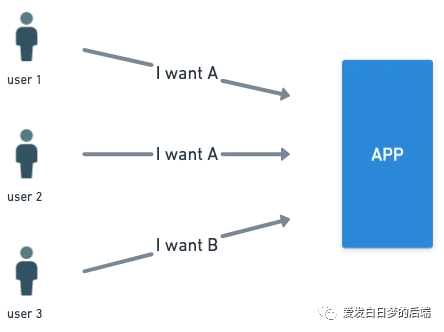使用Singleflight優(yōu)化Go代碼
介紹
有許多方法可以優(yōu)化代碼以提高效率,減少運行進程就是其中之一。在本文中,我們將看到如何通過使用一個Go包Singleflight來減少重復進程,從而優(yōu)化Go代碼。
問題
假設你有一個web應用,它每秒有10個請求(RPS)。根據(jù)您所知道的數(shù)據(jù),其中一些請求具有相同的模式,實際上可以生成相同的結果,這意味著實際上存在冗余流程。

從上面的插圖中,我們知道用戶1和用戶2想要相同的東西,但最終,我們(大多數(shù)情況下)分別處理這兩個請求。
解決方案
Singleflight是可以解決這類問題的Go包之一,如文檔中所述,它提供了重復函數(shù)調用抑制機制。
很酷,如果我們知道我們要調用的函數(shù)是重復的,我們就可以減少處理的函數(shù)的數(shù)量,讓我們看看在現(xiàn)實世界中如何使用它。
實現(xiàn)
我們將創(chuàng)建兩個程序,server.go 和 client.go。
server.go — 將作為web服務,可以接收 /api/v1/get_something 的請求,參數(shù)名為name
// server.go
package main
import (
"fmt"
"net/http"
)
func main() {
http.HandleFunc("/api/v1/get_something", func(w http.ResponseWriter, r *http.Request) {
name := r.URL.Query().Get("name")
response := processingRequest(name)
_, _ = fmt.Fprint(w, response)
})
err := http.ListenAndServe(":15001", nil)
if err != nil {
fmt.Println(err)
}
}
func processingRequest(name string) string {
fmt.Println("[DEBUG] processing request..")
return "Hi there! You requested " + name
}client.go — 將作為一個客戶端,向web服務發(fā)出5個并發(fā)請求(你可以在變量totalRequests中設置這個數(shù)字)。
// client.go
package main
import (
"io"
"log"
"net/http"
"sync"
)
func main() {
var wg sync.WaitGroup
endpoint := "http://localhost:15001/api/v1/get_something?name=something"
totalRequests := 5
for i := 0; i < totalRequests; i++ {
wg.Add(1)
go func(i int) {
defer wg.Done()
makeAPICall(endpoint)
}(i)
}
wg.Wait()
}
func makeAPICall(endpoint string) {
resp, err := http.Get(endpoint)
if err != nil {
log.Fatalln(err)
}
body, err := io.ReadAll(resp.Body)
if err != nil {
log.Fatalln(err)
}
result := string(body)
log.Printf(result)
}首先,我們可以運行 server.go,然后繼續(xù)執(zhí)行 client.go。我們將在服務器腳本的終端中看到如下內容:
[DEBUG] processing request..
[DEBUG] processing request..
[DEBUG] processing request..
[DEBUG] processing request..
[DEBUG] processing request..客戶端的輸出是這樣的:
2023/09/05 10:29:34 Hi there! You requested something
2023/09/05 10:29:34 Hi there! You requested something
2023/09/05 10:29:34 Hi there! You requested something
2023/09/05 10:29:34 Hi there! You requested something
2023/09/05 10:29:34 Hi there! You requested something這是正確的,因為我們從客戶端發(fā)送了五個請求,并在服務器中處理了這五個請求。
現(xiàn)在讓我們在代碼中實現(xiàn)Singleflight,這樣它會更有效率。
// server.go
package main
import (
"fmt"
"net/http"
"golang.org/x/sync/singleflight"
)
var g = singleflight.Group{}
func main() {
http.HandleFunc("/api/v1/get_something", func(w http.ResponseWriter, r *http.Request) {
name := r.URL.Query().Get("name")
response, _, _ := g.Do(name, func() (interface{}, error) {
result := processingRequest(name)
return result, nil
})
_, _ = fmt.Fprint(w, response)
})
err := http.ListenAndServe(":15001", nil)
if err != nil {
fmt.Println(err)
}
}
func processingRequest(name string) string {
fmt.Println("[DEBUG] processing request..")
return "Hi there! You requested " + name
}重新啟動服務器并再次運行客戶端程序后,服務器的終端顯示如下:
[DEBUG] processing request..
[DEBUG] processing request..客戶端的輸出還是沒有變化:
2023/09/05 10:32:49 Hi there! You requested something
2023/09/05 10:32:49 Hi there! You requested something
2023/09/05 10:32:49 Hi there! You requested something
2023/09/05 10:32:49 Hi there! You requested something
2023/09/05 10:32:49 Hi there! You requested something太好了!所有客戶端都得到了預期的響應,但是現(xiàn)在我們的服務器只處理了兩個請求。想象一下,如果您處理數(shù)千個類似的請求,您將帶來多大的效率,這是驚人的!
結論
在本文中,我們了解了Singleflight在優(yōu)化代碼方面的強大功能。不僅僅是處理一個web請求,你還可以將它的用例擴展到其他事情上,比如從數(shù)據(jù)庫中獲取數(shù)據(jù)等等。
還有一些我在本文中沒有涉及的內容,例如Singleflight的過程失敗會怎樣,以及我們如何緩存它。

































